
How can I tell if my dog's heatstroke is serious
Let’s be real: It’s a sticky August morning in Los Angeles, and you took your 2-year-old Golden Retriever, Max, for a walk a little later than usual
Noticing your dog’s waistline disappear and hearing them pant on a short walk can be a wake-up call. You want to help them shed those extra pounds quickly, but the fastest way isn't about crash diets or drastic measures; it's about a safe, strategic, and sustainable calorie deficit created through partnership with your veterinarian. The quickest safe path to canine weight loss is a precise plan that combines measured nutrition, increased activity, and unwavering consistency.
The absolute first and most crucial step is a veterinary visit. This isn't a suggestion—it's a necessity. Your vet will rule out medical conditions like hypothyroidism that can cause weight gain, determine your dog’s ideal target weight, and calculate their exact daily calorie needs. They might recommend a specific prescription metabolic diet or simply advise on the correct portion of their current food. Remember, "quick" doesn't mean rushed. Rapid weight loss can cause serious health issues like hepatic lipidosis (a liver condition). The gold standard is a gradual loss of 1-3% of their body weight per month. Use a measuring cup for every single meal—eyeballing it is a surefire way to overfeed, especially in apartments where treats are often used for training and can quickly add up.

This is where you can creatively accelerate the process. Swap out high-calorie training treats for their regular kibble or low-calorie alternatives like frozen green beans, blueberries, or small pieces of carrot. This allows you to continue positive reinforcement training—rewarding them for calm behavior indoors or good leash manners—without sabotaging their diet. Increase low-impact exercise gradually. Instead of one long walk, try two or three shorter, more frequent walks throughout the day. This boosts their metabolism and helps burn calories more efficiently without overstressing their joints. For apartment dogs, this also provides crucial mental stimulation and helps prevent boredom-related begging.
Your dog’s weight loss journey is also a public health matter. An overweight dog is at higher risk for joint problems, making their leashed walks in the community essential yet potentially harder. This makes your legal duty to always clean up after them even more important, as their diet may be changing and affecting their stool. Carrying waste bags is a non-negotiable law in U.S. municipalities and a sign of respect for your neighbors. Furthermore, ensure your dog’s vaccinations, like rabies, are current before increasing their exposure at parks. If your dog is sluggish or reluctant to exercise, never respond with frustration or force. Using encouragement and their meal-based kibble as rewards for walking a little further aligns with force-free training ethics and strengthens your bond. The quickest way isn't a shortcut; it's the smart, responsible path guided by professional science and compassionate care.

Let’s be real: It’s a sticky August morning in Los Angeles, and you took your 2-year-old Golden Retriever, Max, for a walk a little later than usual

You're enjoying a summer afternoon at the park when you notice your dog has stopped panting and appears disoriented - their gums are bright red

Let’s paint the picture: You’re in your Denver apartment, watching your 4-year-old Boston Terrier, Ruby, plop down mid-play session with her favorite toy

Many dog owners notice their pets nails seem shorter after regular walks,but how much does this daily activity actually help?The answer depends on where you walk—concrete sidewalks or asphalt streets gently file nails as a dog's paws hit the ground

Most dog owners notice their pup scooting across the carpet at some point, but few connect it to impacted anal glands. These small sacs near a dog’s rectum secrete a scent for marking territory

Most vets agree that regular dog teeth cleaning is key to avoiding painful dental issues later. For healthy adult dogs, a professional cleaning at the vet’s office every 12 to 18 months usually works well.